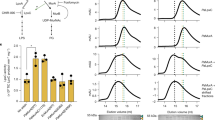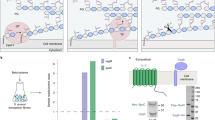Abstract
The classical concept of the architecture of microbial murein assumes cross-linked glycan chains to be arranged in horizontal layers outside of the plasma membrane. It necessitates elaborate hypotheses to explain processes such as the biosynthesis, growth and division of the bacterial cell wall and provides no explanation for transenvelope macromolecular transport. Moreover, this model is difficult to reconcile with a number of basic chemical and electron microscopical data. According to a fundamentally distinct concept which is presented here, glycan strands in the microbial wall run perpendicular to the plasma membrane, each strand being cross-linked by peptide bridges with four other strands. This arrangement allows the formation of a structured matrix pierced with ordered ionophoric channels potentially harboring either lipoprotein or teichoic (lipoteichoic) acid molecules in Gram-negative and Gram-positive bacteria, respectively. New wall structures are synthesized in toto emerging from the cytoplasmic membrane as a condensed gel-like network below the old wall without being covalently attached to it, expanding due to inherent elasticity as the old wall is lyzed. This model reflects published genetic and biochemical data and offers a simple explanation for peptidoglycan biogenesis. As the biosynthesis is terminated by enzymic cleavage of all glycan strands, murein is irreversibly released from the membrane. The murein detachment prepares the membrane for de novo assembly of both the new wall synthesis machinery and the multicomponent factory for protein, DNA and phospholipid transfer. Being assembled in parallel, both new murein and the traffic complexes grow from the membrane together. This concept eliminates the necessity for the traffic complexes to penetrate intact murein. In the process of simultaneous assembly, the expanding murein functions as a lifting platform driven by the force of turgor pressure, transporting macromolecules through the perisplasmic space.
Similar content being viewed by others
Author information
Authors and Affiliations
Additional information
Received: 5 October 1998
Rights and permissions
About this article
Cite this article
Dmitriev, B., Ehlers, S. & Rietschel, E. Layered murein revisited: a fundamentally new concept of bacterial cell wall structure, biogenesis and function. Med Microbiol Immunol 187, 173–181 (1999). https://doi.org/10.1007/s004300050090
Issue Date:
DOI: https://doi.org/10.1007/s004300050090




